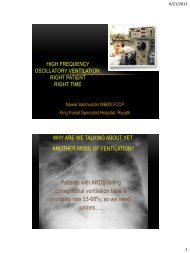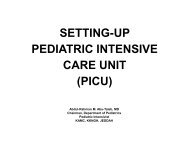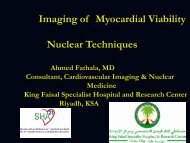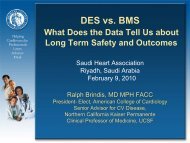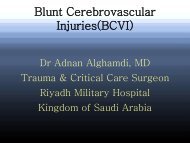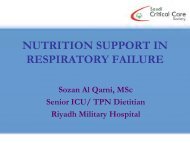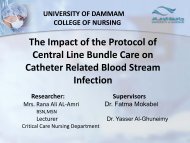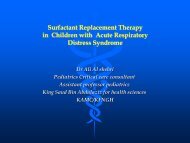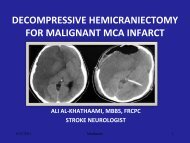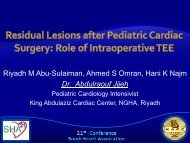Critical Illness Polyneuropathy & Myopathy In Children - RM Solutions
Critical Illness Polyneuropathy & Myopathy In Children - RM Solutions
Critical Illness Polyneuropathy & Myopathy In Children - RM Solutions
Create successful ePaper yourself
Turn your PDF publications into a flip-book with our unique Google optimized e-Paper software.
<strong>Critical</strong> <strong>Illness</strong> <strong>Polyneuropathy</strong> &<br />
<strong>Myopathy</strong> <strong>In</strong> <strong>Children</strong><br />
Dr Mohamed Salim Kabbani<br />
Head, Pediatric Cardiac ICU<br />
King AbdulAziz Medical City- Riyadh<br />
1
Objectives<br />
• Definition of CIP and CIM<br />
• Spectrum of the Diseases<br />
• Manifestations of each type<br />
• High Risk Cases<br />
• Diagnosis<br />
• Management<br />
2
<strong>Critical</strong> <strong>Illness</strong> Neuropathy and <strong>Myopathy</strong><br />
• <strong>Critical</strong> illness <strong>Polyneuropathy</strong> (CIP), first described by<br />
Bolton and colleagues in 1986<br />
• Most common acquired neuromuscular condition in<br />
adult ICU<br />
• Almost affects 50% of patient with sepsis and multiorgan<br />
dysfunction syndrome (MODS)<br />
• Neurology Clin 28(2010)961-977<br />
3
Spectrum of manifestation<br />
• <strong>Critical</strong>ly ill patient<br />
• Symmetric weakness<br />
• Flaccidity<br />
• Different degree of muscle atrophy<br />
• Reduction or absence of deep tendon reflexes<br />
• Distal loss of sensation<br />
• Facial and ophthalmic muscle are less affected<br />
• Different degree of encephalopathy<br />
• Symptoms may start after 3 days of illness<br />
4
<strong>Critical</strong>ly ill<br />
Flaccid<br />
weakness<br />
Neuromuscular<br />
Weakness<br />
Related to<br />
<strong>Critical</strong> <strong>Illness</strong><br />
ICU<br />
settings<br />
<strong>In</strong>cidence:<br />
Adults, 25 % of ICU patients.<br />
Pediatrics, less common.<br />
5<br />
Respiratory<br />
dysfunction,<br />
Ventilated
How common is critical illness polyneuropathy & myopathy?<br />
• Early development of critical illness myopathy and<br />
neuropathy in patients with severe sepsis<br />
• 48 patients with severe sepsis in ICU<br />
• Abnormal nerve conduction study (NCS) in 63%<br />
• 50% of patients developed neuromuscular dysfunction<br />
6<br />
Neurology , 2007 68:1529-1535
Onset time of critical illness myopathy and/or neuropathy<br />
during intensive care unit (ICU) stay<br />
<strong>Critical</strong> Care 2007, 11:R11 (doi:10.1186/cc5671)<br />
• Multi-center study<br />
• 92, ICU patients<br />
• Daily measurements of<br />
the action potential<br />
amplitude and nerve<br />
conduction velocity<br />
• 30% developed either<br />
CIMP or CINP<br />
7
What About <strong>Children</strong>?<br />
How common is <strong>Critical</strong> illness myopathy and neuropathy?<br />
• All children admitted to PICU of Sick <strong>Children</strong> Hospital<br />
of Toronto over 1 year were evaluated 3 times/week<br />
• Age 3 months to 17 years<br />
• Muscle weakness, reduced DTR, inability to wean MV<br />
• <strong>In</strong>cidence : 14/ 830 (1.7%)<br />
• 3 children under 3 years (0.7 %)and 11 above 10 years<br />
of age (5.1%)<br />
NEUROLOGY 2003;61:1779–1782<br />
8
ICU Related Neuromuscular<br />
weakness<br />
<strong>Critical</strong><br />
<strong>Illness</strong><br />
<strong>Myopathy</strong><br />
CI<br />
<strong>Polyneuropathy</strong><br />
Mixed<br />
Type of<br />
Both<br />
Prolonged<br />
NMJ<br />
Blockade<br />
Others<br />
GBS<br />
Rhabdomy<br />
olysis<br />
Cachectic<br />
myopathy<br />
Myopathies<br />
9
10<br />
CRITICAL ILLNESS MYOPATHY
Type of <strong>Critical</strong> <strong>Illness</strong> <strong>Myopathy</strong><br />
• Acute necrotizing myopathy<br />
– Occur after sepsis and trauma<br />
– Generalized muscle weakness<br />
– High serum creatine kinase<br />
– Myoglobinurea<br />
• <strong>Myopathy</strong> associated with NMB or Corticosteroid<br />
– Diffuse muscle weakness<br />
– Muscle atrophy<br />
11
<strong>In</strong>cidence<br />
<strong>In</strong>cidince<br />
Acute RDS,<br />
3%<br />
Organ<br />
Transplant,<br />
7%<br />
Severe Sepsis<br />
33%<br />
IV<br />
Glucocortico<br />
steroids<br />
MOF<br />
50%<br />
12
<strong>In</strong>crease<br />
Severity of<br />
Disease<br />
Hyperglycemia<br />
CRITICAL<br />
ILLNESS<br />
MYOPATHY<br />
Systemic<br />
<strong>In</strong>flammatory<br />
Response<br />
IV Steroid<br />
13<br />
NMB<br />
Strongest<br />
Factor<br />
Rare without<br />
exposure<br />
IV<br />
Steroid<br />
NMB
Risk Factors<br />
• Sepsis<br />
• SIRS<br />
• Hyperosmolaility<br />
• TPN use<br />
• GCS< 10<br />
• ARDS<br />
• Pancreatitis<br />
• Burn<br />
• Asthma<br />
• Organ Transplantation<br />
• Renal or hepatic Failure<br />
Steroid<br />
NMB<br />
Aminoglycoside<br />
Hyperglycemia<br />
14
Muscle weakness in critically ill children<br />
Neurology 2003;61: 1779-1782<br />
• 840 Patient included<br />
• 14 patients (Ave 12 y/o)developed weakness (1.7 %)<br />
• Age distribution 3 < 3years of age, 11> more than 10<br />
• Under 3 years (0.5%)<br />
• More> 10 years (5.1%)<br />
• Length of PCICU stay (4 days- 11 days)<br />
• 12/14 (86%) required ventilation > 5days<br />
• 9 / 14 received corticosteroid<br />
• 9/14 received NMB<br />
• 57% were transplant patients<br />
• 4/14 Died (29%)<br />
15
Diagnostic Criteria<br />
ICU,<br />
ventilated,<br />
Paralyzed<br />
IV steroid,<br />
several<br />
days<br />
CIM<br />
Failure to wean MV not related to<br />
cardiopulmonary disease<br />
Flaccid Proximal Quadriparesis<br />
Normal sensation, DTR normal/Decreased<br />
<strong>In</strong>creased CK (around day 4),<br />
50-80%, might be without CIM<br />
Electrophysiologic Study,<br />
Nerve conduction study, EMG<br />
Muscle Biopsy ,<br />
Electronic Microscope (Loss of Myosin)<br />
16
Neurology 2003;61: 1779-1782<br />
17<br />
Normal muscle<br />
Muscle from sick child
Pathology<br />
• Scattered atrophic<br />
fibers<br />
• Loss of ATPase<br />
activity<br />
• Loss of Myosin<br />
• Loss of myosin thick<br />
filaments<br />
18
Figure 1 Direct muscle stimulation<br />
Zink, W. et al. (2009) <strong>Critical</strong> illness polyneuropathy and myopathy in the intensive care unit<br />
Nat. Rev. Neurol. doi:10.1038/nrneurol.2009.75<br />
19
Management Strategy<br />
<strong>In</strong>crease<br />
Severity<br />
of Disease<br />
<strong>In</strong>sulin (80-110, 4.4-6.1)<br />
Aggressive Management<br />
Hyperglycemia<br />
CRITICAL<br />
ILLNESS<br />
MYOPATHY<br />
SIRS<br />
D/C or Decrease IV Steroid<br />
and NMB ASAP<br />
Aggressive Management<br />
IV Steroid<br />
20
Prevention<br />
Management<br />
• Supportive<br />
• Rehabilitation<br />
• Avoid the<br />
Occurrence<br />
Prognosis<br />
• Recovery within<br />
wks to months<br />
• Variable<br />
residual<br />
weakness<br />
• ICU stay,<br />
Morbidity,<br />
Mortality<br />
21
ICU Related Neuromuscular weakness<br />
<strong>Critical</strong><br />
<strong>Illness</strong><br />
<strong>Myopathy</strong><br />
CI<br />
<strong>Polyneuropathy</strong><br />
Mixed<br />
Type of<br />
Both<br />
Prolonged<br />
NMJ<br />
Blockade<br />
Others<br />
GBS<br />
Rhabdom<br />
yolysis<br />
Cachectic<br />
myopathy<br />
Myopathies<br />
22
23<br />
CRITICAL ILLNESS POLYNEUROPATHY
Mechanism<br />
Axonal Degeneration<br />
70 %<br />
(not clear)<br />
<strong>In</strong>tact Nerves, 30 %<br />
24
Sepsis<br />
High<br />
Sugar<br />
<strong>Critical</strong> illness<br />
Neuropathy<br />
SIRS<br />
Low<br />
Alb<br />
25
<strong>In</strong>cidence<br />
Major Factor<br />
Onset<br />
Motor System<br />
Sensory Function<br />
DTR<br />
Facial M and Cranial N<br />
Prognosis<br />
More common<br />
IV steroid<br />
CIM<br />
Several days of IV steroid<br />
Proximal<br />
Preserved<br />
Usually normal<br />
Preserved<br />
Better, Wks to Months,<br />
Residual weakness<br />
Less common<br />
CIP<br />
Severe Sepsis, SIRS, MOF<br />
After 1-2 wks of SIRS (average<br />
28 days)<br />
<strong>In</strong>volves distal<br />
Affected<br />
Usually absent<br />
Usually Preserved<br />
Wks to Months, Residual<br />
weakness<br />
May remain quadriplegic<br />
Management<br />
26<br />
Supportive, Preventive, <strong>In</strong>sulin<br />
Supportive, Preventive, <strong>In</strong>sulin
Diagnostic Criteria<br />
ICU,<br />
ventilated,<br />
Paralyzed<br />
Sepsis,<br />
SIRS, MOF<br />
CIP<br />
Failure to wean MV not related to<br />
cardiopulmonary disease<br />
Flaccid Quadriparesis<br />
Abnormal sensation distally, Cranial N<br />
preserved, DTR Absent/Decreased<br />
Normal CK, Normal CSF protein<br />
Electrophysiologic Study, NCS, EMG<br />
Muscle Biopsy (Treatable Condition)<br />
It is difficult to differentiate CIM from CIP clinically.<br />
27
28<br />
Major electroneurographic features in axonal<br />
and demyelinating neuropathy
Loss of<br />
myelinated<br />
nerve fibers<br />
Degenerating<br />
myelin<br />
Clusters of<br />
Schwann cell<br />
without nerve<br />
fibers<br />
29<br />
<strong>Critical</strong> Care 2004, 8:R358-R366 (DOI 10.1186/cc2925)
Limitation To Sensory & Motor Function Assessment<br />
• Sedation<br />
• Paralytic Agents<br />
• <strong>In</strong>tubation<br />
• Neonates and <strong>In</strong>fants<br />
• <strong>Critical</strong> <strong>Illness</strong><br />
• Mixed Type<br />
30<br />
It is difficult to differentiate CIM from CIP clinically.
Management Strategy<br />
<strong>In</strong>crease<br />
Severity of<br />
Disease<br />
<strong>In</strong>sulin (80-110, 4.4-6.1)<br />
Aggressive Management<br />
Hyperglycemia<br />
CIP<br />
SIRS<br />
Maintain normal Albumin levels?<br />
Aggressive Management<br />
Low Alb<br />
31
Prevention<br />
Management<br />
• Supportive<br />
• Rehabilitation<br />
• Avoid the<br />
Occurrence<br />
Prognosis<br />
• Recovery within<br />
wks to months<br />
• Variable residual<br />
nerve dysfunction<br />
for years<br />
• May remain<br />
quadriplegic<br />
• ICU stay,<br />
Morbidity,<br />
Mortality<br />
32
33<br />
PROLONGED NEUROMUSCULAR JUNCTION<br />
BLOCKADE
ICU Related Neuromuscular weakness<br />
<strong>Critical</strong><br />
<strong>Illness</strong><br />
<strong>Myopathy</strong><br />
CI<br />
<strong>Polyneuropathy</strong><br />
Mixed<br />
Type of<br />
Both<br />
Prolonged<br />
NMJ<br />
Blockade<br />
Others<br />
GBS<br />
Rhabdom<br />
yolysis<br />
Cachectic<br />
myopathy<br />
Myopathies<br />
34
NEJM, 1992, 327, 524-528<br />
•16 critically ill received Vecuronium<br />
• NMB> 2 days<br />
•7/16 had prolong paralysis > 6 hours<br />
after stopping NMB<br />
• 7/7 had renal impairment<br />
• High serum Mg level<br />
•Liver impairment<br />
•Acidosis<br />
35
Prolonged use (days) of paralytic agents<br />
Renal or hepatic insufficiency<br />
Prolonged circulation of drug<br />
metabolites<br />
Bind irreversibly to acetylcholine<br />
receptors<br />
<strong>In</strong>hibiting neuromuscular transmission<br />
Flaccid Paralysis<br />
36
Paralytic<br />
Agents<br />
Aminosteroid<br />
Benzyliso<br />
quinolone<br />
Pancuronium<br />
Vecuronium<br />
Cisatracorium<br />
Doxaurium<br />
Degenerated in the kidney and the<br />
liver into active metabolite<br />
Degenerated in the blood into inactive<br />
metabolite<br />
37<br />
affected by renal, hepatic and<br />
cardiac insufficiency<br />
Not affected by renal, hepatic or<br />
cardiac insufficiency
Diagnosis and Management<br />
Anti-<br />
Achorase<br />
Pyridostigmin<br />
Clinical<br />
Improvement<br />
Support<br />
Diagnosis<br />
Rx<br />
Management<br />
Avoidance<br />
Aminosteroid<br />
Agents<br />
Use<br />
Anti-acetyl<br />
cholinesterase<br />
Agents<br />
38
Preventive measures<br />
• Avoid use of muscle relaxant<br />
• Monitor muscle strength during paralysis<br />
• Daily interruption of sedation and<br />
paralysis<br />
• Monitoring of brain activity<br />
• Remember risk factors:<br />
NMB, Aminoglycoside, steroid, Renal<br />
failure<br />
N Engl J Med<br />
2000;342:1471-<br />
39
Conclusion<br />
• <strong>Critical</strong> illness neuromyopathy is frequently<br />
under-diagnosed<br />
• Sepsis and MOF are risk factor<br />
• Steroid, NMB, hyperglycemia, aminoglycoside<br />
are potential incriminating factors<br />
• Early recognition and Diagnosis are important<br />
• Management is based on preventive and<br />
supportive measures<br />
40
The magic spinach<br />
is not yet there<br />
Thanks<br />
41



